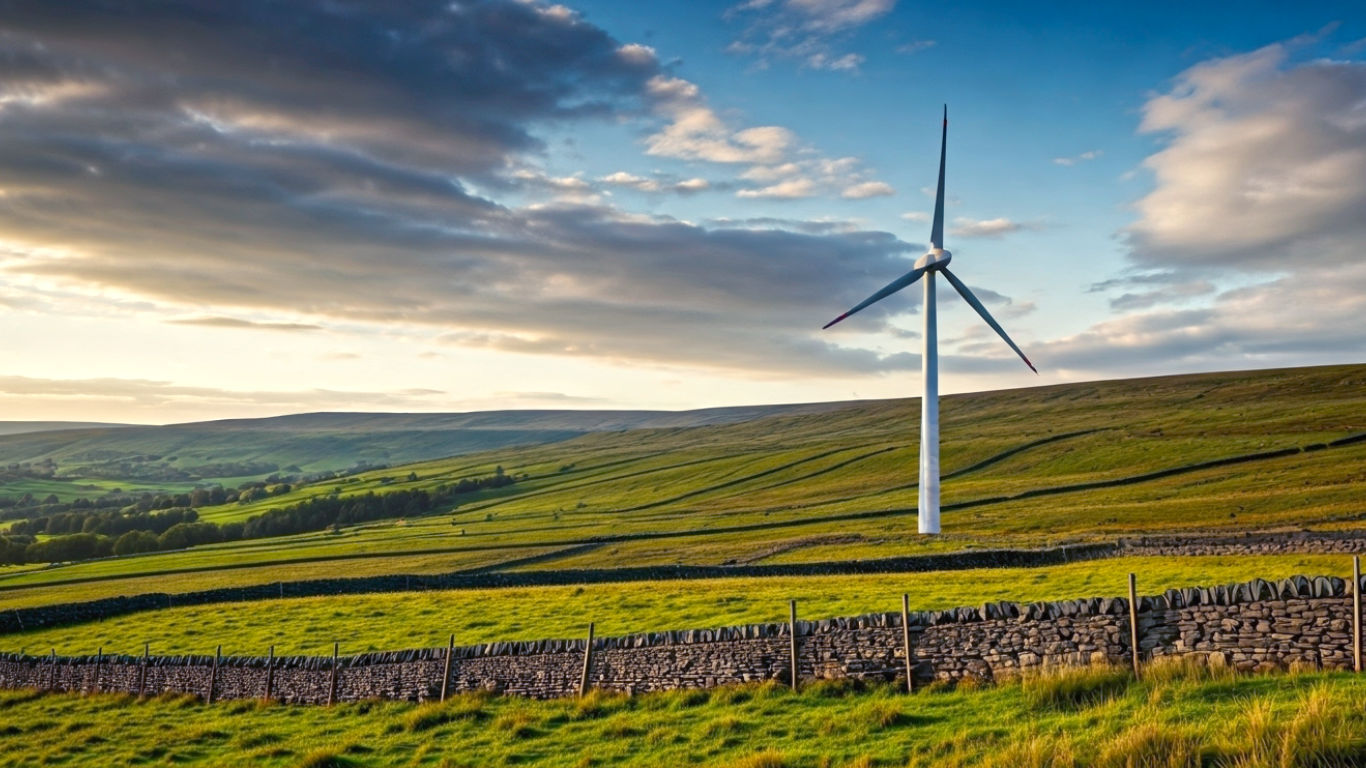How Much Does a Wind Turbine Cost in the UK?
Your guide to approximate wind turbine costs in the UK. We break down the complete price for home, farm, and large-scale projects.

This post may contain affiliate links. If you make a purchase through these links, we may earn a commission at no additional cost to you.
Ever looked out at the rolling British countryside and seen those huge, graceful blades turning in the wind? You’ve probably wondered what’s going on up there. Are they making money? Could you get one for your own home or farm? And the big question everyone asks: how much do they actually cost?
It’s a simple question with a surprisingly tricky answer. The cost isn’t just a single price tag; it’s a mix of the turbine itself, the installation, connecting it to the grid, and keeping it running. It can range from a few thousand pounds for a tiny rooftop model to millions for a giant you’d see out at sea.
But don’t worry. We’re going to break it all down. This is your ultimate guide to wind turbine costs in the UK for 2025. We’ll look at everything from small systems for your garden to massive turbines for a commercial wind farm. We’ll cover the upfront costs, the hidden extras, how much money you could make, and whether it’s a smart investment for you.
So, let’s get started and demystify the price of harnessing the great British wind.
Understanding the Basics: What Are You Paying For?
Before we dive into the numbers, it’s helpful to know what makes up the total cost of a wind turbine system. It’s not just about buying the turbine itself. The final bill is a package deal.
Think of it like buying a car. You don’t just pay for the engine and the wheels. You’re paying for the chassis, the electronics, the delivery, and getting it registered. A wind turbine is similar. The main costs fall into a few key baskets:
- The Turbine: This is the machine itself—the blades, the tower, the generator (the bit that makes the electricity), and the gearbox. The bigger and more powerful the turbine, the more this part will cost.
- Installation & Construction: This is a huge part of the budget. It includes preparing the ground, laying concrete foundations (which can be massive!), hiring a crane to lift the tower and turbine into place, and all the labour involved. For larger turbines, this is a major construction project.
- Grid Connection: You need to connect your turbine to the National Grid to sell the electricity you generate. This involves digging trenches, laying armoured cables, and paying the local District Network Operator (DNO) to hook you up. This cost can vary wildly depending on how far you are from a suitable connection point.
- Planning and Surveys: You can’t just put a wind turbine up wherever you fancy. You’ll need to pay for planning applications, environmental impact assessments, noise surveys, and checks to make sure it won’t interfere with radar or flight paths.
So, when we talk about cost, we’re talking about the total installed cost. It’s the full price to get your turbine from a factory to spinning in a field and generating power, approximately. Don’t forget that market-driven, and local factors can alter the cost, so take these figurees as they are intended – illustratively. Actual costs may vary.
Small-Scale Wind Turbines: Powering Your Home or Small Business
Let’s start small. These are the turbines you might see on the roof of a house, in a large garden, or powering a smallholding. They are perfect for homeowners, small businesses, or farms looking to reduce their electricity bills and carbon footprint.
We generally split them into two types:
- Micro-Turbines (Under 5kW): These are the smallest of the bunch. They can be mounted on a pole in your garden or, in some cases, fixed to the roof of your house (often called ‘roof-mounted’).
- Small Turbines (5kW to 50kW): These are a bit bigger and stand on their own towers. They’re popular for farms, rural businesses, and communities that need more power.
How Much Do Small Turbines Cost in 2025?
The price of small wind turbines has become more competitive over the years, but it’s still a significant investment. Here’s a rough breakdown of the fully installed costs you can expect in 2025.
| Turbine Size (Power Output) | Typical Use | Estimated Installed Cost | Potential Annual Output* |
|---|---|---|---|
| 1kW – 2kW | Powering a shed, off-grid cabin, caravan | £3,000 – £7,000 | 1,500 – 3,000 kWh |
| 5kW | Large home, small farm, reducing bills | £20,000 – £30,000 | 7,500 – 10,000 kWh |
| 15kW | Farm, rural business, small community hall | £50,000 – £75,000 | 25,000 – 35,000 kWh |
| 50kW | Large farm, industrial unit, school | £150,000 – £250,000 | 80,000 – 120,000 kWh |
*Potential annual output depends heavily on the average wind speed at your site. These are just estimates.
What’s Included in That Price?
For a typical small turbine project, the costs above should cover:
- The turbine and tower.
- The inverter (this converts the electricity for use in your home or the grid).
- Delivery and installation, including the concrete base.
- Wiring and connection to your property’s fuse box.
What Are the Hidden Extras?
This is where it gets tricky. The sticker price often doesn’t include everything. Watch out for:
- Planning Application Fees: Budget around £500 – £2,000 for the various reports and council fees. Noise and ecology surveys can add thousands more if required.
- Grid Connection Costs: This is the big one. If you’re lucky, connecting to the grid might cost £1,000 – £5,000. But if the local grid needs to be upgraded to handle your turbine’s power, the cost could spiral to £20,000 or even more. Always get a firm quote from your DNO before you commit.
- Battery Storage: If you want to store your energy to use when the wind isn’t blowing, a home battery system (like a Tesla Powerwall or similar) will add another £5,000 – £10,000 to your bill.
Is a Small Wind Turbine Worth It? Making the Money Back
Okay, so it’s a big outlay. How do you make your money back? It comes from two places:
- Saving Money on Your Bills: Every unit of electricity your turbine generates is one you don’t have to buy from your supplier. With average electricity prices in the UK hovering around 25-30p per kilowatt-hour (kWh) in 2025, this can add up fast. A 5kW turbine producing 8,000 kWh a year could save you over £2,000 annually.
- Selling Surplus Energy: What you don’t use, you can sell back to the grid. This is done through the Smart Export Guarantee (SEG) scheme. Energy suppliers are required to pay you for the electricity you export.
The Smart Export Guarantee (SEG) in 2025
The Feed-in Tariff (FIT) scheme, which was very generous, closed to new applicants in 2019. Its replacement, the SEG, isn’t as lucrative, but it still provides a valuable income.
Under the SEG, the rate you get is set by individual energy suppliers. In 2025, rates are quite variable. Some offer as little as 4p/kWh, while the best fixed-rate tariffs are around 15p/kWh. Some innovative suppliers offer “agile” tariffs that can spike much higher when demand is high, but these are less predictable.
Let’s do some quick maths for a 5kW turbine:
- Annual Generation: 8,000 kWh
- Electricity You Use (50%): 4,000 kWh (Savings: 4,000 kWh x 28p = £1,120 per year)
- Electricity You Export (50%): 4,000 kWh (Income: 4,000 kWh x 15p = £600 per year)
- Total Annual Benefit: £1,120 + £600 = £1,720
With an installed cost of £25,000, the simple payback period would be around 14-15 years. Since a well-maintained turbine can last 20-25 years, it can be a solid long-term investment, especially if electricity prices continue to rise.
A Quick Word on Roof-Mounted Turbines: Be very careful with these. They are often sold with big promises but rarely deliver. The wind flow over a roof is turbulent and messy, meaning they produce far less power than a pole-mounted turbine in a clear, open space. Most experts in the UK advise against them.
Medium-Scale Wind Turbines: The Farmer’s Favourite
Now we’re moving up a size. These are the single, medium-sized turbines you often see standing alone in a farmer’s field. They are a popular choice for landowners and agricultural businesses looking to create a serious new income stream.
These turbines typically range from 100kW to 500kW in power. They are big machines, with towers reaching up to 50-80 metres high.
How Much Do Medium-Sized Turbines Cost?
This is a serious commercial investment. The total project costs are significant, but so are the potential returns.
| Turbine Size (Power Output) | Total Project Cost (Estimated) | Who Is It For? |
|---|---|---|
| 100kW | £350,000 – £450,000 | Dairy farms, large rural businesses |
| 250kW | £700,000 – £900,000 | Large arable farms, food processing plants |
| 500kW | £1.5 million – £2 million | Landowners, industrial estates, community energy projects |
What Drives These Costs?
At this scale, the project becomes much more complex. The costs are driven by:
- The Turbine Price: A 250kW turbine from a reputable manufacturer like Enercon or EWT will cost several hundred thousand pounds.
- Civil Engineering Works: The foundations for a 500kW turbine can require over 300 cubic metres of concrete and tons of steel reinforcement. You also need to build an access road capable of taking heavy lorries and a massive crane.
- The Grid Connection: This is often the deal-breaker. Connecting a 500kW turbine can cost anywhere from £50,000 to over £500,000 if the local network requires major upgrades, like a new substation. The DNO will do a detailed study to give you a final quote, which itself can cost thousands.
- Planning and Legal Fees: The planning process for a turbine this size is rigorous and expensive. You’ll need professional reports on landscape impact, noise, ecology, archaeology, and aviation. Legal fees for land leases and grid connection agreements also add up. Budget for at least £30,000 – £100,000 for these “soft costs.”
The Financials: A Serious Business Investment
Unlike a small home turbine, a medium-sized turbine is all about the return on investment. The electricity generated is usually far more than the owner can use, so most of it is sold to the grid.
Let’s look at a 250kW turbine as an example.
- Average Wind Site: A good spot in the UK might have an average wind speed of 6.5 metres per second.
- Annual Output: This turbine could generate around 550,000 kWh per year.
- Total Project Cost: Let’s say £800,000.
How Does It Make Money?
The income comes from selling the electricity. The owner would sign a Power Purchase Agreement (PPA) with an energy supplier or business. A PPA is a long-term contract to buy the electricity at an agreed price.
In 2025, the market price for wholesale electricity is volatile. A long-term PPA might offer a fixed price of around 16-18p per kWh.
- Annual Income: 550,000 kWh x 17p = £93,500
Now we have to subtract the running costs.
Running Costs: Maintenance and Business Rates
A turbine isn’t a ‘fit and forget’ technology.
- Maintenance: You’ll need an annual service contract. For a 250kW machine, this could be £8,000 – £12,000 per year. This covers regular servicing, insurance, and repairs.
- Business Rates: The local council will charge business rates on the turbine. This can be a nasty surprise, sometimes costing £5,000 – £10,000 per year.
- Land Lease: If you don’t own the land, you’ll pay a percentage of the income to the landowner, typically 10-15%.
Let’s factor those in:
- Annual Income: £93,500
- Annual Costs (Maintenance + Rates): £12,000 + £7,000 = £19,000
- Annual Profit (before tax and finance): £93,500 – £19,000 = £74,500
With a project cost of £800,000, the payback period is around 10-11 years. Given the 25-year lifespan of the turbine, that’s a very attractive commercial return, which is why they have been so popular with farmers and landowners.
Large-Scale Wind Farms: The Giants of the Grid
Finally, we have the huge, multi-megawatt turbines that make up the big wind farms you see clustered on hillsides (onshore) or out at sea (offshore).
These projects are on another level entirely. They are developed by major energy companies, and the costs run into the tens or even hundreds of millions of pounds.
- Onshore Wind Turbines (2MW – 5MW each): A modern onshore turbine is a beast. The tower can be over 100 metres tall, with blades 60-70 metres long.
- Offshore Wind Turbines (10MW – 15MW each): These are the largest machines on the planet. The latest models stand over 250 metres tall from sea level to blade tip—taller than London’s ‘Gherkin’ skyscraper.
What Do Wind Farms Cost?
We usually talk about the cost of wind farms in pounds per megawatt (£/MW) of capacity. This allows us to compare projects of different sizes.
- Onshore Wind Farm Cost: In 2025, the average cost to build a new onshore wind farm in the UK is around £1 million to £1.3 million per MW. So, a medium-sized 50MW farm with 10 large turbines would cost roughly £50 million – £65 million.
- Offshore Wind Farm Cost: Building out at sea is much more expensive due to the harsh environment, specialist ships, and huge underwater foundations. The cost is currently around £2.5 million to £3.5 million per MW. A giant 1,000MW (1 Gigawatt) offshore farm like Hornsea Two would cost in the region of £3 billion.
Amazingly, the cost of offshore wind has plummeted over the last decade. It used to be far more expensive, but thanks to massive turbines and a mature UK supply chain, it’s now one of the cheapest forms of new electricity generation we have—cheaper than new gas and nuclear power.
How Are They Financed and Who Profits?
These huge projects are financed by large utility companies (like SSE, ScottishPower, and Ørsted), investment funds, and pension funds.
They make their money through government-backed contracts called Contracts for Difference (CfD). In a CfD auction, wind farm developers bid to provide electricity at a fixed “strike price.”
For example, in the 2023 auction, offshore wind farms secured contracts at prices around £44 per MWh (which is just 4.4p per kWh) in today’s money.
If the market price for electricity is higher than their strike price, the wind farm pays the difference back to the government (and ultimately, the consumer). If the market price is lower, they receive a top-up. This gives them a guaranteed income, making these huge investments safe and predictable.
It’s this CfD scheme that has driven the incredible growth of offshore wind, making the UK a world leader.
Key Factors That Influence the Final Cost
As you can see, the price can vary enormously. Let’s summarise the key variables that will affect your final bill, no matter the size of the project.
- Wind Speed: This is the most important factor. A site with 10% more wind can produce 30% more power. A professional installer will use a device called an anemometer to measure your site’s wind speed for at least a year before recommending a turbine. Don’t just guess!
- Location and Access: Is your site easy to get to? A remote, hilly location will mean higher costs for cranes and construction vehicles.
- The Grid Connection Point: How far is it, and does it have enough capacity? This is the biggest and scariest unknown. Get a quote early in the process.
- Ground Conditions: Rocky or boggy ground will make laying foundations more difficult and expensive.
- Planning Permission: Some areas are more sensitive than others. If you’re near a National Park, an Area of Outstanding Natural Beauty (AONB), or a historic site, getting permission will be tougher and more costly.
The Future of Wind Turbine Costs in the UK
What does the future hold? The trend is positive.
- Technology is Improving: Turbines are getting bigger, more efficient, and more reliable. This is especially true for the offshore market, where 20MW turbines are already being designed.
- Costs are Falling: While inflation has caused a recent bump, the long-term trend for large-scale wind is downwards. Manufacturing at scale and competition are driving prices down.
- Energy Storage is Key: The combination of wind turbines and battery storage is the next big step. This will allow us to store wind power for when it’s needed most, making the grid more stable and reducing waste. As battery costs fall, expect to see them paired with wind projects of all sizes.
For the homeowner or farmer, the picture is more stable. The costs of small and medium turbines are not expected to fall dramatically, but as electricity prices rise, the financial case for installing them will only get stronger.
So, Is a Wind Turbine a Good Investment in 2025?
Let’s wrap it all up. Is investing in a wind turbine in the UK a good idea today?
- For Homeowners: A small wind turbine is a major financial decision with a long payback time. It’s more of a lifestyle choice for those passionate about reducing their carbon footprint and gaining energy independence. For most people, solar panels combined with a battery offer a quicker and more reliable return on investment.
- For Farmers and Landowners: A medium-scale turbine remains a very strong business case. If you have the right site (windy, not too visible, and near a grid connection), it can provide a reliable, diversified income for 25 years. It’s a complex project, but the rewards can be substantial.
- For the UK: Large-scale onshore and especially offshore wind are the bedrock of our future energy system. They are now the cheapest way to generate new electricity, they provide energy security, and they are crucial in our fight against climate change. The multi-billion-pound investments are creating tens of thousands of skilled jobs around the country, particularly in coastal communities.
Harnessing the wind is in our DNA. From the historic windmills that once dotted the landscape to the super-sized turbines now powering our nation, it’s a story of British innovation. The costs are significant, but the value—in clean energy, economic growth, and a sustainable future—is even greater.
Further Reading
For those looking to dive deeper, these resources provide reliable and up-to-date information on renewable energy in the UK:
- Energy Saving Trust: An independent organisation providing impartial advice on energy efficiency and renewables for homeowners. https://energysavingtrust.org.uk/
- Centre for Sustainable Energy (CSE): A charity offering detailed advice and resources on community energy and domestic renewables. https://www.cse.org.uk/
- Ofgem (The Office of Gas and Electricity Markets): The UK’s energy regulator, with official information on the Smart Export Guarantee and grid connections. https://www.ofgem.gov.uk/
- RenewableUK: The trade association for the wind, wave, and tidal industry in the UK, with news and reports on the commercial sector. https://www.renewableuk.com/






